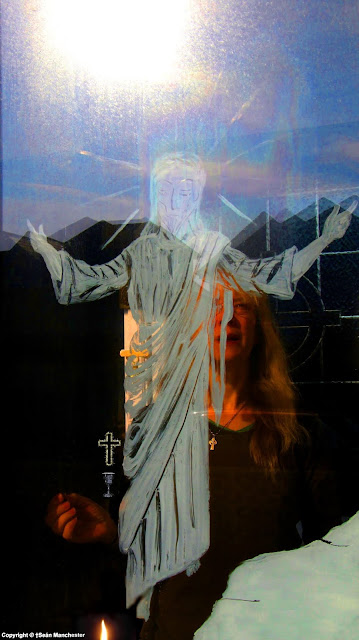The anchor to those mentioned is a man born five months after the deceased in 1946. His history, especially from the late Sixties, through the Seventies, to the Eighties, is enmeshed in the above. He gave himself the nickname "Eggman," was mostly known as Tony in general circumstances, "Ants" to intimates, "Arturo" in past writings and correspondence, and now answers to the name "Antonio."
To those of us who knew him in the context of the studio where he was employed part-time in the afternoons (until 1968), he was Arthur. He remains Arthur, as far as I am concerned, but this tripartite association with Farrant, Frewin and Bradish (the latter two were unknown to me even though I knew them by sight), was always to be a disturbing fact. I would describe them as belonging to the criminal class because of their inherent moral degeneracy. Bradish has only one criminal conviction of which I am aware, while Farrant and Frewin received prison sentences for a raft of offences in the Seventies.
Every time I have attempted to broach him on these matters, as I did earlier today regarding Frewin, Arthur's response remains the same, evoking an uncomfortable feeling of historic collusion of silence.
Everything was fine between Arthur and I until he absconded with Mary (whom he called "Maura"), the wife of David Farrant, and quit with next to no warning his part-time-job at the studio. They ran off to Devon for six months. Mary became pregnant with her second child, and, upon returning to Highgate, prepared to join her parents in Southampton after giving birth. This she did in August 1969. Meanwhile, Farrant was that month evicted from their flat, suffered the ignominy of becoming bankrupt, and finding himself homeless, Arthur offered him the coal bunker beneath his own ground floor flat in Archway Road, not far from where he had met Mary, a barmaid, in The Woodman pub.
Astonishingly, Farrant accepted the offer from the man who had run off with his wife a few months earlier, and made the best of his new situation; occasionally popping up the cellar stairs to make a cup of tea. Their association, however, continued well into the Eighties. Farrant had been arrested in August 1970, and did not return to his coal bunker upon being released. Instead, he was accommodated by someone he knew (they had met in the Prince of Wales pub) who also had an eye for Mary. His name was James Bradish. Farrant loathed Bradish and sought to cause him maximum trouble because of the revelation Mary made to her husband of Bradish making a pass at her when they were alone together. Bradish, who liked Farrant, arranged for his friend's release from Brixton Prison by offering him lodgings at his home in Manor Road, Barnet, and organising employment (as a porter) at Barnet General Hospital. During this fairly brief period, Gillian Bradish received anonymous black magic telephone threats. Soon afterwards, Farrant found a bed-siting room over a chemist shop in Archway Road, almost opposite where Arthur, his wife and family resided at Priestwood Mansions.
Farrant by now had appointed his friend Frewin to be his personal "minder." Frewin happily obliged, and threatened anyone whom Farrant pointed the finger at. I was to receive a number these threats. Un-intimidated, I chose to ignore Frewin's unpleasant overtures. These reached a crescendo when I attended, along with a friend (Katrina Garforth-Bles), a supposed black magic duel between David Farrant and John Pope on the first Hallowe'en following Farrant's release from prison in 1976. This curious spectacle with press and public fully in attendance took place in Highgate Wood after dark.
Frewin came straight up to Katrina and I, snarling and spitting. I looked over at Farrant and indicated that he should call his baying hound off. He didn't. However, there was a large police presence that Frewin was not entirely oblivious to, and, as they approached, the "minder" moved into the shadows.
The concern I have always had is the Bradish and Frewin connection where Arthur Hill is concerned.
David Farrant with James and Gillian Bradish at Manor Road (above).
They Walk Among Us CLICK ON IMAGE BELOW TO ACCESS PODCAST






















































